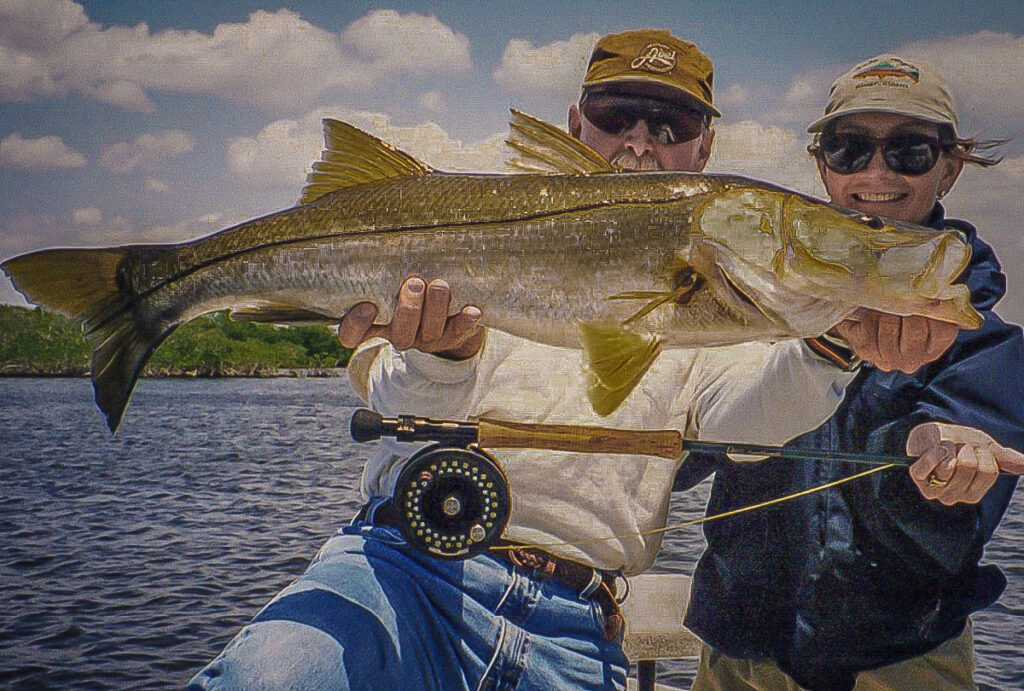Email Cell -305.393.1245
HOME » Snook
 I’ve spent much of my career as a fishing guide exploring Everglades National Park’s coastal waters and hidden interior shallows, helping anglers experience the thrill of catching snook on fly or light tackle. With over 30 years as a full-time fishing guide and a lifetime of angling, if I could chase just one fish for the rest of my life, it would be the snook. Their strength, acrobatics, beauty, and the incredible habitats they call home make them my ultimate passion.
I’ve spent much of my career as a fishing guide exploring Everglades National Park’s coastal waters and hidden interior shallows, helping anglers experience the thrill of catching snook on fly or light tackle. With over 30 years as a full-time fishing guide and a lifetime of angling, if I could chase just one fish for the rest of my life, it would be the snook. Their strength, acrobatics, beauty, and the incredible habitats they call home make them my ultimate passion.
When it comes to sight fishing, the opportunities for snook in Everglades National Park are second to none. Snook are almost always lurking near structure and will use every trick in the book to show you who’s boss. The best time to fish for snook in this part of Florida is from early fall to late spring, when the Everglades’ winding creeks, shallow sawgrass ponds, and mangrove-lined bays come alive. After a chilly cold front, these areas warm up quickly, creating perfect conditions. The clear, tannin-stained waters, often filled with hydrilla, bladderwort, periphyton, and baitfish, are home to snook, redfish, largemouth bass, and more.
Many seasoned anglers who’ve already checked bonefish, tarpon, and permit off their list find themselves drawn to snook as their next obsession. And it’s easy to see why.
These wary predators thrive in the most remote and hard to get to corners of the Everglades, places far from boat traffic and angling pressure. If it’s hard to reach, you can bet a snook will be there. For me, part of the fun is getting to those out-of-the-way spots and sharing the adventure.
Snook are a fascinating mix of personalities: stealthy like a bonefish, acrobatic and tough like a tarpon, and sometimes so intuitive it feels like they’re reading your mind, especially on windless, cool days. While you can find snook year-round in the Everglades, my favorite time to target them is when South Florida’s weather starts to cool down, usually between October and March.
For snook, an 8 to 9-weight rod paired with a floating or clear floating line works well. In some cases, a clear sink-tip or clear floating line can be a better choice for wary fish, offering a more stealthy presentation than a standard floating line.
I use a variation of the IGFA big game leader with a 25 lb class tippet, typically tying leaders between 8 to 10 feet in length. Increasing the bite tippet length from the standard 12 inches to 30 inches helps reduce visibility between knots and extends the life of your leader. This extra length allows you to trim off damaged sections and re-tie without needing to replace the entire leader.
*I practice catch and release only so I’m not interested in adhering to IGFA line classes and leader specs for records. I do believe there should still be a weak link in the leader system that will break before the fly rod does in the event of a knotted flyline getting jammed going through the guides.
Snook are aggressive predators, and your fly selection should mimic their natural menu. Recommended patterns include:
Flies should be tied on 1/0 to 2/0 hooks, and in areas with thick cover—such as mangroves or deadfall—weed guards can be a game-changer. If you’re bringing your flies, feel free to call or email for recommendations on colors and hook sizes that work best in specific conditions.
A fast-action spinning or plug setup spooled with #4 diameter braided line (15 lb test) is ideal for snook. Few things match the thrill of a topwater strike, and these lures are among the most effective:
Soft plastics such as jerk baits, swimbaits, paddle tails, tubes, jigs, and worms are also productive, as are classic bucktail jigs, shallow-running plugs, and spoons.
I was initially skeptical about braided line, but after watching a client muscle a big snook out of the mangrove roots, where monofilament would have failed, I became a believer. Braided line (#4 diameter, 15 lb test) paired with a 30-inch fluorocarbon leader (30 lb to 40 lb test) is a highly effective setup for snook on spin or plug gear.
Everglades National Park began collecting entrance fees for all park visitors on January 10, 2019 – including anglers with licensed fishing guides, Effective January 2025, 7-day passes will be $35 per person. You may also purchase an annual Everglades National Park pass for $70. Children aged 15 and under are always admitted free.